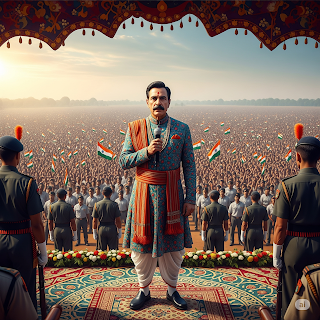Delivering a lecture in Kerala the other day, N Ram,
former editor of The Hindu, described
Narendra Modi’s style of governance as “incremental authoritarianism.” Democracy is slowly but steadily being eroded
in India by Modi. How does he do it?
· Consolidation
of executive power
· Undermining
of judicial independence or press freedom
· Weakening of
opposition parties
· Use of state
apparatus to target dissent
· Erosion of
civil liberties
· Nationalist
rhetoric used to delegitimize critics
· Misinformation
and disinformation spread via all available forms of media and propaganda machinery
· Disdain for
the Constitution of the country
The Parliament is a mere scarecrow
today. A scarecrow in a Waste Land.
Mr Modi doesn’t even attend the sessions most of the time. He is abroad usually
when the Parliament meets to pass some bills like the ones related to criminal
justice such as the Bharatiya Nyaya Sanhita which replaced the Indian Penal
Code. The most recent instance is the Waqf (Amendment) Bill 2025.
Modi’s political party possesses what
has come to be known as “brute majority” which is also called “tyranny of the
majority.” These ‘brutes’ don’t think for themselves. Modi’s wish is their
command. If Modi tells them to drink cow’s urine, they will eat the dung too.
Institutions such as the Election
Commission, judiciary, and enforcement agencies are mere puppets in Modi’s
hands now. Activists and journalists are arrested under draconian laws like the
UAPA and sedition statutes. Anyone who dares to question Modi beyond Modi’s
tolerance level (which is not much) will face a raid from the CBI, ED or IT
department. Most of the media channels that matter have been bought off by Modi’s
friends or have been muted enough. India’s position on Word Press Freedom Index
is pathetic. Reporters
Without Borders describes the condition of India’s press as “very serious.” 
From creativehatti.com
N Ram’s concern is that
democracy will soon die in India. Mr Modi will be India’s dictator
though elections will continue to take place. India has a long way to go in
this regard since Modi is only 74. Contrast that with Trump, 78, and Mao Zedong
who lasted till 83+. Celal Bayar of Turkey reached an age of 103! Dictators live
long.
And they reward their chelas.
Last Republic Day, a woman known as Sadhvi Rithambara was awarded one of the
highest civilian honours: the Padma Bhushan. What did this woman do to merit
that recognition? She called for a war on India’s Muslims. The Liberhan
Commission, formed to investigate the demolition of Babri Masjid, had listed
this woman among 68 people culpable of taking the country “to the brink of communal
discord.” She was honoured by Narendra Modi for that service!
In 1995, this woman had declared that
“Christians will be wiped out from the face of India.” In 2002, she founded an
organisation called Durga Vahini, a women’s wing of the Vishva Hindu Parishad.
One of their major contributions to the country is the blackening of the face
of Neetu Sapra, director of a play which Rithambara didn’t like. The Muslims in
India are now her hobby horse.
I present this woman only as a case
study. There are too many like her in Modi’s India: vicious hate-mongers who go
on to win the highest national honours or top positions. That is another way of
killing democracy. Subtly.
Back to N Ram. It is much more than
incremental authoritarianism that India has to deal with now. How will India do
it? I don’t know. I am not even very hopeful. However, I have a friend who is
convinced that
“the democratic sagacity and wisdom of the Indian mystical pluralism… will cut
to size the magical hocus-pocus of the Sangh Parivar” in the due course of
time. But dictators live long!


Hari Om
ReplyDeleteThis erosion of democracy may indeed be incremental, but it is not slow! The rot is everywhere. Deeply concening... YAM xx
The biggest concern, probably, is that too many citizens seem to approve what the Man does.
DeleteSadly, this is happening in far too many places.
ReplyDeleteToo many places, yes. Some kind of global phenomenon. Wonder whether any sociologist or some such scholar is looking for the reason.
DeleteYes, it's sad. Not just here, world over. Many commentators describe it as a backlash. It's a cycle. One gives way to the other. When we have good and convincing alternative, we will see a change. Till then, we wait.
ReplyDeleteThat waiting is the only alternative left to us ordinary mortals, it seems.
DeleteThis is a template set globally, i feel. This dictators were just puppets set the country a business place for arms, chemicals and GMOs!!!
ReplyDeleteUltimately war business runs the world?
Delete